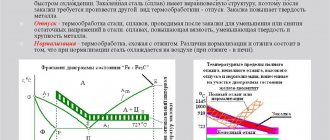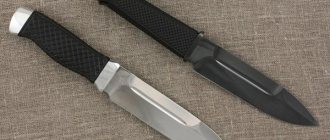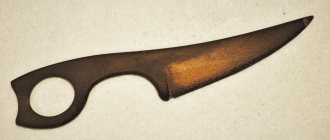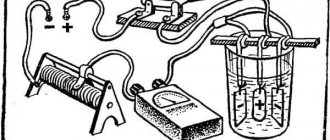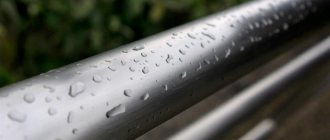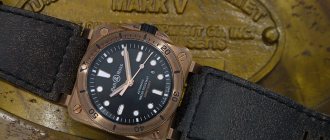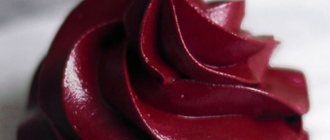What can be achieved by bluing
As a result of chemical or thermal treatment, a layer of iron oxide with a thickness of 1 to 10 microns appears on the surface of a steel part. The thickness of the layer is determined by the selected processing technology.
Blueing of metal allows you to achieve two main goals:
- Increasing the corrosion resistance of the product. Treated parts do not rust.
- Improved appearance. It is especially important for those parts that, due to operating conditions, cannot be painted.
Temperature conditions for bluing
The treatment does not affect other properties of the steel.
Blueing of steel is possible not only in production conditions, but also at home. There are many methods and compositions, almost all of them involve the use of chemically active substances that can cause serious harm to health. To successfully and safely use these substances at home, you must follow the following safety rules:
- Use a protective mask and gloves.
- Ensure ventilation of the room in which work is carried out.
- Use stainless steel utensils.
- Do not exceed the recommended processing temperature.
What is bluing?
Steel bluing is a treatment during which steel is coated with an oxide film. In this case, the product is exposed to chemical or thermal effects. The thickness of the surface coating with an oxide layer can reach 10 mm.
Burnishing is considered an effective method of combating rusty metal and the spread of corrosion. If the stages of the selected bluing technology are carried out correctly, complete elimination of rust can be achieved. Burnishing is applied to those blanks that will not be painted in the future.
At the same time, the process of increasing corrosion resistance and changing the appearance does not in any way affect other parameters of metal products. When carrying out processing, the features of bluing should be taken into account:
- observe safety precautions;
- adhere to the specified temperature regime for heating the workpiece;
- When working, use utensils made of galvanized metal.
This way you can protect the body from harmful fumes and increase the effectiveness of your actions.
Methods for bluing metals at home and requirements for their implementation
Popular methods of bluing metal at home are:
- Boiling in self-prepared or purchased chemical compositions.
- Coating the steel with special oil and subsequent heat treatment.
- Coating the surface with the prepared composition at room temperature.
Burnishing steel at home
Chemical bluing of iron also involves preparatory operations of etching and cleaning, as well as grinding and polishing.
When carrying out blueing of steel, it is important to select a container for the solution so that it completely covers the object being treated.
Steel blueing
Hot bluing most often helps achieve a blue color. This happens when heated for a longer time. Initially, the surface acquires white, yellow, purple shades, and the result is a beautiful blue color.
Recipe 1
Burnishing steel at home using this method requires the presence of a forge, ideally with automatic blowing. Birch charcoal should be placed in a metal box, leaving room for the metal that needs to be processed.
This structure is placed in a preheated forge. The metal is smeared with vinegar, wiped and placed in a box when the coal begins to smolder. If a bluish color appears, the part must be pulled out, cooled a little and returned to its place. Such manipulations should be done 3-4 times until the correct shade is obtained.
Recipe 2
This method of obtaining blue color is carried out without heat treatment. You will need 3 grams of hexacyanoferrate (“red salt” popularly) and iron sesquichloride. For safety reasons, chemical components must be added to water, but not vice versa.
These substances are highly soluble and are strong oxidizing agents. Add them separately to 0.5 liters of water, stir and mix into one substance. We dip the steel into the resulting solution until it acquires the desired color.
Popular bluing methods
The most common methods of bluing at home are:
- alkaline;
- thermal;
- acidic.
The alkaline method is well suited for self-use at home. It will require
- water;
- precision scales;
- sodium nitrate and hydroxide.
For the coating to become durable, the process must last at least an hour and a half.
Alkaline
The technology for bluing steel using the alkaline method at home is divided into the following operations
- Degrease the surface with a solvent or special degreaser.
- Pour 100 g of water into a stainless steel container with a capacity of at least a liter.
- Add 120 g of caustic soda and 30 g of sodium nitrate, stir thoroughly until completely dissolved.
- Heat the solution to 130-145 °C.
- Place the product in the dish, avoiding touching the walls.
- After 20 minutes, after the part has turned black, rinse it in distilled water.
- After drying, generously lubricate the product with machine oil and wipe thoroughly.
Steel bluing with alkali
Careful adherence to proportions and parameters will allow you to obtain a smooth and abrasion-resistant coating that does not require polishing.
Important! The product must be completely covered with the solution throughout the treatment. Otherwise, coating inhomogeneities, color transitions, etc. are possible.
Acid
This method involves the use of acidic solutions.
Before starting processing, you should carefully remove all rust from the surface of the object. To do this, use ordinary sandpaper, and in hard-to-reach places and with severe rust, use a grinder or a screwdriver with a wire brush.
Means for degreasing steel before processing
Next, chemical cleaning is carried out. It is used for
- sodium triphosphate;
- ethanol mixed with kerosene;
- or pure kerosene.
The product is placed in a container with the solution so that it completely covers it and kept for at least a quarter of an hour. After cleaning, the product is washed with plenty of water and dried.
The composition for acid bluing consists of:
- water: 1 l;
- tannic acid: 2g;
- tartaric acid: 2g.
After thorough mixing and complete dissolution, the composition is heated to 150 ° C and the workpiece is completely immersed in it. Leave for 15 minutes, then rinse with running water and briefly dip in boiling water for complete and high-quality rinsing.
Components of the solution for bluing
The last stage of the process is soaking in machine oil for an hour. After drying, the product is ready for use.
Thermal
Thermal bluing is the oldest and simplest method for home use. The whole process boils down to heating the steel in the open air. It lasts until the upper layers of steel react with oxygen in the air and result in an oxide film. The more a part is heated, the darker it becomes.
Thermal bluing
It should be remembered that heat treatment also changes the physical properties of the steel of the entire product.
Selection of technology for bluing parts
To choose the right bluing method, it is advisable to decide on a number of specific parameters and recommendations:
- In the case of restoration of damaged coating, the extent of existing damage should be determined. If you need to revive limited areas where there are scratches or small abrasions, the choice is made on the alkaline method of producing an oxide film on the metal surface.
- If the surface of the part is significantly damaged and there is corrosion on it, the existing coating will have to be completely removed.
- Each product has a certain value. Based on this, it is worth estimating how long subsequent operation is expected. If the item will spend most of its time on the wall as an exhibit, simple chemical processing methods are possible.
- For products actively used on hikes or in the open air (knives, utensils or firearms), thermal methods using oil are used.
- When performing work to order, much depends on the price that the customer can pay. Cheap orders are carried out using simple methods, expensive ones involve the use of more expensive bluing techniques. When performing work for third-party customers, the question is: “How much does it cost?” – will be very relevant.
- At the training stage you will have to pay for everything yourself. Any professional training is expensive, but self-learning the basics of the profession has the advantage: knowledge is acquired without additional payment to the mentor.
All that remains is to study the basic methods of applying an oxide film, and then practice the techniques through real experience and gain the necessary skills.
Features of chemical bluing and recipes for some compositions
Before applying a new coating at home, you must remove the old one. This is done by combining mechanical and chemical cleaning methods.
To obtain a durable and beautiful coating, the part must be boiled for 30 to 90 minutes, during which time part of the solution boils away. The workpiece must be completely covered with the composition at all times, so the composition must be prepared with a reserve and periodically topped up during boiling.
At the end of the chemical bluing procedure, the product should be washed in a soapy solution, dried and generously lubricated with oil.
There are many options for chemical bluing. In some, the composition is made by the master himself, while others involve the use of ready-made factory-made products, such as Parisian oxide, Voron3M, Clover and others.
Bottom line
Thus, using simple bluing methods, you can process the knife and give it an interesting appearance. It is also worth listening to the advice and following the instructions, then the oxidation procedure will go without problems.
Previous
KnivesWomen's folding knife for self-defense - an exquisite accessory
Next
KnivesKnife cleaver or tisak: the main tool in survival conditions
Means for bluing metals
Relatively simple methods of bluing, available for doing it yourself, include surface application of oil, saltpeter and the purchased composition “Clover”
Sapphire for bluing
Oil coating
This is one of the most popular home methods. The technology is divided into the following operations:
- The part is sanded and degreased with a solvent.
- Cover with oil.
- In a muffle furnace it is heated to 350-400 °C. It is permissible to use an oven.
- The cooled part takes on a black or brown tint.
- To saturate the color, the procedure is repeated.
The oil is applied with a brush or by dipping the product into a container of oil. Different types of oil are used, such as
- weapons;
- olive;
- flaxseed
Use of saltpeter
Home craftsmen achieve excellent results using saltpeter solution. You can purchase a ready-made solution, or you can make it yourself:
- water-1000 ml;
- sodium nitrate - 0.5 kg;
- caustic soda - 0.5 kg.
After boiling for an hour, a smooth surface of a deep blue-black color is obtained that does not require further processing.
Means "Clover"
The gel-like product can be purchased in 50 ml jars and is used for alloys with a chromium content of no more than 3 percent
Means "Clover"
It is designed to restore localized corrosion. To obtain a bright shade, the product will have to be applied several times. The product should first be sanded and wiped with a degreaser.
Apply clover with a brush and leave for two minutes. The white-yellow coating that appears is washed off with water and the part is wiped with a rag.
Thermal bluing of parts
In industrial conditions, they prefer to perform bluing using a thermal method. Usually this operation is combined with low tempering, which relieves internal stresses inside steel products:
- The part is heated in a muffle furnace for 20...30 minutes to a temperature of 180...220 ⁰C.
- The removed part is wiped with machine oil using a swab. It is advisable to treat all surfaces.
- If necessary, the treatments are repeated.
- Usually, a double heat treatment is sufficient to obtain a high-quality blued surface.
Information: weapons factories producing firearms and bladed weapons use thermal bluing. The coating on many products lasts more than 100 years. Example, Mosin rifles manufactured in 1891 and Nagan revolvers released at the end of 1888.
Republished by Blog Post Promoter
Cold bluing at home
“Clover” does not require heat treatment of the part, so this method is considered cold bluing. Cold bluing can be carried out by other means.
- "Voron-3M". The drug forms a dense film of deep black color on the surface.
- "Paris Oxide" An imported selenium-based preparation is supplied in three containers: 1- for surface preparation, 2- the main composition and 3- a fixative that gives the coating additional protection.
Liquid for cold bluing is applied to the parts with a brush, and after painting it is washed off with warm soapy water. The method is popular for processing barrels and other parts of firearms that do not require boiling.
Burnishing steel at home
If you are bluing steel at home, you need to wisely choose the components of the boiling solution. Heating hardened parts can lead to them losing their strength properties.
Alkaline solutions have a less harmful effect on steel, and experienced craftsmen advise choosing them. Treatment with acidic solutions is preferably carried out at low temperatures
So, for example, when using an acid composition for bluing steel from:
- calcium nitrate – 94%;
- orthophosphoric acid – 3%;
- manganese dioxide – 3%.
processing is carried out from half an hour to 45 minutes at 100 ° C
The simplest ways
Most housewives have vinegar, tea and citric acid at home. And Coca-Cola lovers can not only wash off tar from their cars with it, but also use it to blue metal.
We will not describe each method, since they are almost the same and are most often used for blackening knives and other kitchen utensils. Let us describe the method of bluing a knife.
So, we will need any of these ingredients:
- Table vinegar.
- Citric acid – 1 sachet.
- Coca-Cola (you need to release the gas in advance).
- Black tea (infusion).
Now about the technology of metal blackening.
- The knife needs to be degreased and poured boiling water over it to keep it hot.
- Any of the listed liquids is filled into a plastic bottle with the neck cut off so that only the handle remains outside.
- The knife must be shaken frequently to ensure that there are no air bubbles on the blade.
- Periodically, the knife should be removed from the liquid and the blade should be wiped, removing oxides in this way.
- When the metal becomes the desired color, the bluing process stops.
The coating is not very durable. If desired, it can be removed and reapplied.
In your comments, you can talk about your method of bluing at home, sharing your opinion and impressions of the work performed.
Metal blackening
Depending on the acidity of the environment in which the workpiece is processed, the color of the resulting coating changes, from yellow to black. Therefore, bluing and blackening of metal are not the same thing. The required shade is selected by varying the intensity and duration of heat treatment and the percentage of solution components.
Metal blackening
If you take a mixture of 7 parts copper nitrate and 3 parts alcohol denatured alcohol, apply it to the product and heat it over a fire, then as it heats up the coating begins to change its color. When the desired shade is achieved, stop heating.
It is also possible to blacken steel by coating it with oil and calcining it in an open flame. The result is a durable film of deep black color. There are other compositions for blackening.
Application of rust varnish
The method using the so-called “rusty varnish” is distinguished by its cost-effectiveness against the backdrop of quite acceptable quality of the coating.
The product is immersed in a chemically active corrosive liquid based on hydrochloric acid, which forms red and black oxides on its surface.
To remove rusty deposits, you will have to use a stiff wire brush. A black oxide film will remain on the product.
Ready rusty varnish
The method is long and labor intensive, but provides excellent results at home.
Before starting processing, as with all other methods, you should thoroughly clean the object with sandpaper and degrease it with a solvent.
The active liquid is prepared in special porcelain vessels; the use of protective gloves, an apron, acid-resistant shoes and thick work clothes is mandatory. A respirator and clear face shield should also be used.
A small amount of hydrochloric acid is poured into the vessel, adding rust scraped off the iron, sawdust and nitric acid. The mixture should be stirred carefully with a porcelain stirrer until bubbles stop appearing.
Next, carefully add water and vodka in equal parts. The solution is allowed to settle and drained from the sediment.
The result of using rusty varnish
The part is placed in the solution for a time sufficient to acquire a deep black color. At the end of the process, the part should be rinsed with plenty of water.
Attention! The solution used in this method is one of the strongest solvents. Beware of even the smallest splashes - they can cause very serious injury and property damage.
If splashes get on clothes, they should be removed immediately. If, despite all precautions, drops get on the skin, the affected area should be washed generously with a soda solution and immediately seek medical help.
Coca Cola
Another way to blacken a knife at home is using Coca-Cola. By the way, this drink is very versatile and is most often used not for its intended purpose, but for all kinds of experiments, including with metals. So, to blue a knife in Coca-Cola you will need:
- glass or metal container made of stainless metal;
- Coca Cola;
- knife.
The bluing process is similar to the previous one, but does not require heating. To bluing using this method, you need to place the knife in the drink for a day or two, periodically turning it over and releasing the bubbles. After this time, you need to replace the drink with a new one and re-place the knife there. This procedure must be performed until the knife acquires a beautiful black color, usually within a week, changing the drink every two days. Make sure that the Coca-Cola completely covers the knife by 5 centimeters and do not forget to turn it over periodically, since bubbles accumulating on the surface of the knife will interfere with the blackening process.
After this, you need to rinse the knife well in clean water, possibly with some soap, and lubricate it with machine or gun oil. Without lubrication, rust appears on the metal very quickly; it becomes visible already during the drying process.
This method of bluing is best suited for narrow, flat surfaces; for example, bluing a bayonet in this way will allow you to achieve a more even coating than on any complex surface with many bulges and bends. In addition to Coca-Cola, you can also use Pepsi-Cola. Blackening occurs due to phosphoric acid, which is part of these drinks.
This method of bluing a knife is quite durable. According to reviews, even if small scratches appear during use, the coating does not come off. In addition, the product turns out absolutely smooth, as if it had not been subjected to any influence. The only disadvantage of such bluing is that it takes quite a long time and requires constant contact with the product (it is necessary to turn the knife up to 4-6 times a day), since otherwise the bubbles will result in piebald inclusions on the surface of the knife.
